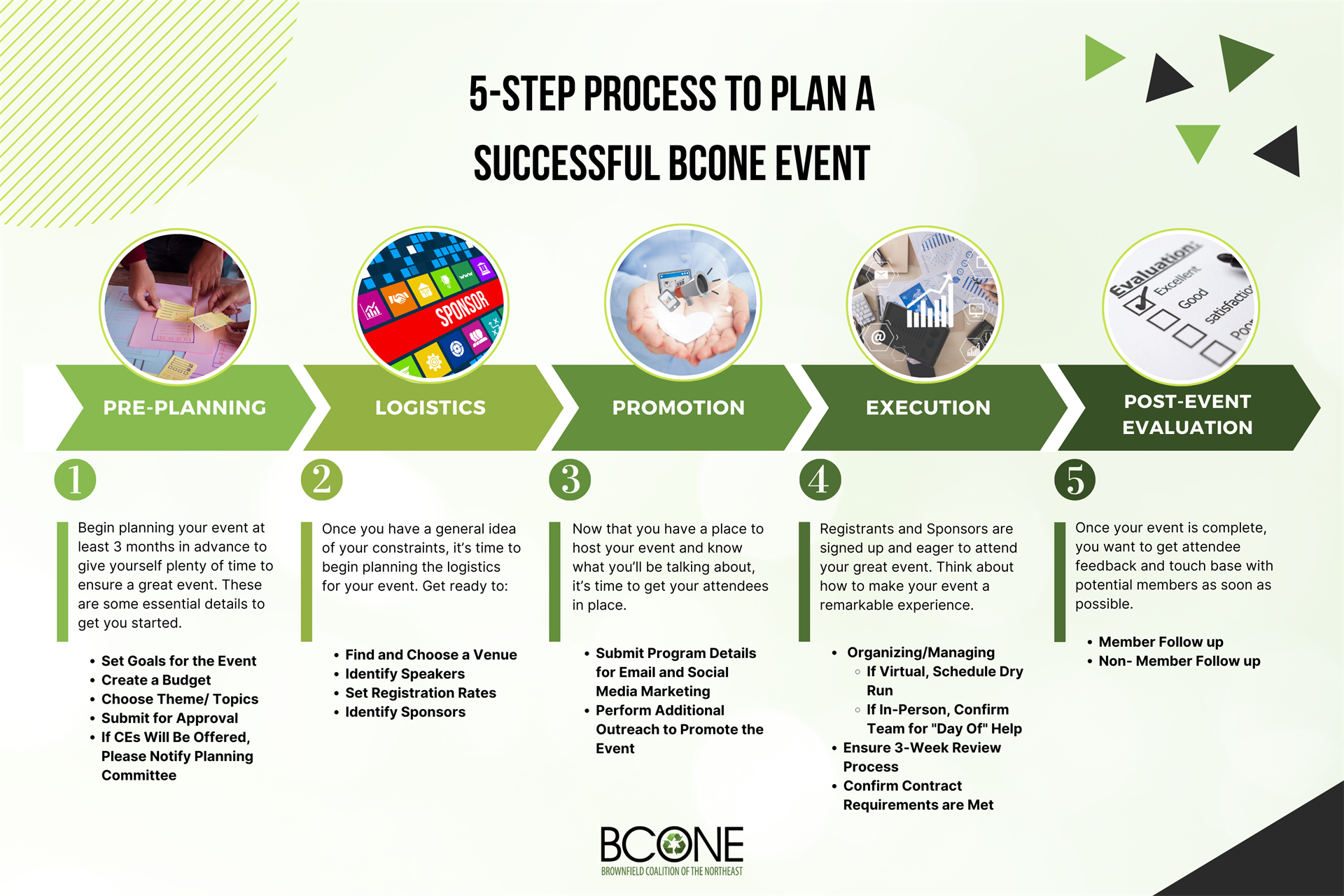STEPS TO PLANNING A SUCCESSFUL EVENT

Here is a 5-step process to plan a successful BCONE event. Once you have a basic idea of the following, you will submit your event request using the following form: https://bit.ly/bcone-event-planning-form
1. Pre-Planning - Before you announce your event and start worrying about getting your speakers and location, you first need a few essential details.
- Goals – As a committee you should set expectations for your event. Your goal should include things like what you want your attendees to walk away learning, how many registrants you want, and if it’s a paid event, a profitability goal as well.
- Budgets –Knowing your event budget will help keep your planning efforts grounded and practical. Be sure your budget includes costs for locations, staff, food/drinks if applicable.
2. Logistics - Once you have a general idea of your constraints, it’s time to begin planning the logistics for your event.
- Venue – Choosing a good location is key to a great event. Consider pricing, space requirements, and parking when selecting a venue. Please select a date that is convenient for the venue and presenters, and that doesn’t conflict with other BCONE events. Submit contract documents (if applicable) to Tiesha Green (tagreen510@gmail.com). Remember to note the venue cancellation policy. Pricing and contract documents will be reviewed by the Executive Team before being finalized.
- Sponsors – One way to help support your budget is through sponsors. When planning a regional event, initial sponsorships should cover the approximate $750 for BCONE administrative costs. Spend some time contacting local businesses to see if they would be willing to sponsor. Be sure to emphasize the outstanding networking opportunity that is available.
- Content – Themes/Topics – The topics and themes for your event significantly impact both your speakers and marketing efforts. While it’s OK to have sessions on a range of topics, having an overarching theme for your event can help you focus on subject matter experts and supporting content you can use during your marketing efforts and will also help with getting Continuing Education Credits approved (if applicable).
- Speakers – Having the right speakers can really make your event stand out. It's important to find speakers who will capture your audience’s attention and tailor their presentations to your audience. That way, you can be sure that everyone will get the most out of it.
3. Promotion
- Submit program details for Email and Social Media Marketing
- Perform Additional Outreach to Promote the Event
- Signage
4. Execution - Now that you have a place to host your event and know what you’ll be talking about, it’s time to get your attendees in place.
- Undergo pre-event 2-week review process (Note: If you do not have a minimum of 20 registrants by this time, the event may be postponed).
- Organizing/Managing – Having a team to assist with “day-of” logistics is essential to ensuring the success of your event. Have a copy of the registration list handy to check people in as they arrive. Verify that all contractual obligations are fulfilled. Take plenty of pictures of your attendees and presenters enjoying the event.
- Marketing – Events that open registration early tend to have higher levels of participation due to the longer time frame for promotional activities.
- Confirm contract requirements are met with the venue
5. Post Event Evaluation
- Member Follow up - Following up with members after an event is an important step in the process of evaluating the success of the event and making improvements for future events. Gathering feedback helps the organization to understand the members' needs, preferences. One way to gather feedback is through conducting surveys or interviews with attendees. This can be done through online surveys, email or phone calls. (Note: Events that offer NJ LSRP Continuing Education Credits will require a specific survey to be provided by the Event Producer, Tiesha Green).)
- Non-Member Follow up – Following up with non-members after an event is an effective way to gather feedback, understand their needs, and increase their interest in becoming a member. It is also an opportunity to showcase the benefits of becoming a member and how the organization can add value to their lives, and is an opportunity to learn more about their needs, interests, and how the organization can better serve them.

